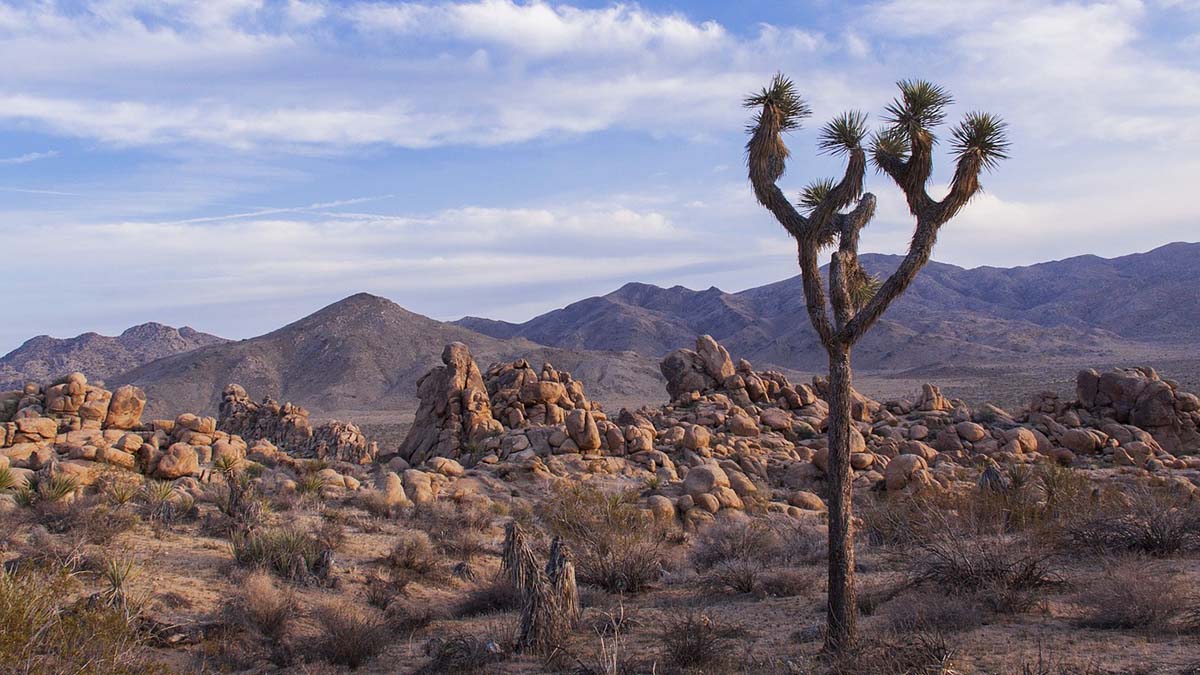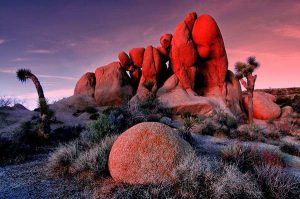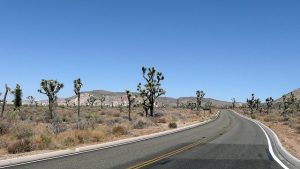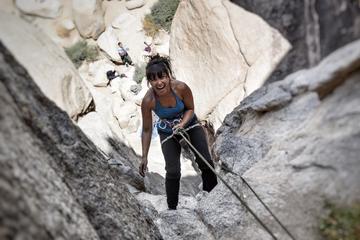
Trees, Rocks, and Much More…
by Patricia M. Evans
I’ve never been much interested in rocks. I’ve always seen them as lumps of matter, squatting sullenly in the earth. So when I started on a journey through the Joshua Tree National Park, near Palm Springs, California, I never expect to be so excited and amazed by the rocks found there, or by the intriguing Joshua Tree forest which gives the park its name.
 I had a day in which to explore the main features of the park by car. I entered from the Cottonwood (East) Gate where the friendly park rangers hand out pamphlets and information. The park contains two different types of desert, Colorado and Mojave. The Pinto Basin Road leads from the Cottonwood gate into the Colorado desert ecosystem, drier and lower than the Mojave ecosystem.
I had a day in which to explore the main features of the park by car. I entered from the Cottonwood (East) Gate where the friendly park rangers hand out pamphlets and information. The park contains two different types of desert, Colorado and Mojave. The Pinto Basin Road leads from the Cottonwood gate into the Colorado desert ecosystem, drier and lower than the Mojave ecosystem.
I drove for a long time through expansive open space without seeing anybody or anything other than plants. Although the desert is full of life, it is not immediately apparent. Coyotes, bobcats, jackrabbits and kangaroo rats are some of the species which live in the park, but except for the tracks of a roadrunner, I saw no other signs of life.
The silence of the desert is a cliché which does not apply to those found in the Joshua Tree Park. There is a constant, slightly chilly wind which whines in your ear and stirs the dry branches of the creosote bushes, the ocotillo and the yucca. Tiny whispering movements in the sand indicate the movements of insects and small creatures.
 About 20 miles north of the Cottonwood Entrance, is the Chollo Cactus Garden. These fearsome cacti grow waist high and are covered with long, dangerous spines. There is a nature loop through the garden where you can come face to face with these menacing desert plants and the life they support. Looking at them, you realize how formidable the spines are and how precarious life is in the desert, to be defended in such a determined fashion.
About 20 miles north of the Cottonwood Entrance, is the Chollo Cactus Garden. These fearsome cacti grow waist high and are covered with long, dangerous spines. There is a nature loop through the garden where you can come face to face with these menacing desert plants and the life they support. Looking at them, you realize how formidable the spines are and how precarious life is in the desert, to be defended in such a determined fashion.
From the Chollo Cactus Garden, the road leads into the Mojave Desert Ecosystem, which is slightly higher, moister and more interesting. It is here that you begin to see the rocks and trees for which the park is famous. I was unprepared for the rock formations when they began to appear. Scattered across the landscape, they did not live up to my conception of rocks as lumps of matter. The formations rise from flat ground, often 50 or more feet high and 100 feet or more in diameter. The pamphlets handed out by the Park Rangers give a convoluted geological description of the birth of the rock formations. The explanation is not nearly as convoluted as the physical appearance of the rocks. The formations literally writhe across the landscape, still carrying within them the agony of the incredible eruptions which forced them to the surface. Golden brown, crumpled and rounded by eons of erosion, they are twisted, folded back on themselves, piled up in tortured heaps. I was not surprised to see that one of the areas was called “Wonderland of Rocks,” a most appropriate name.
 In the Mojave Desert ecosystem the Joshua Trees appear in large numbers. Made famous as the title of a U2 album, the Joshua Tree is a giant member of the lily flower family. The trees are tall, sometimes reaching 40 feet in height, with six or seven branches or arms covered with spines that reach up to the sky. They were given their unusual name by Mormon travelers who thought that the upraised branches of the tree resembled the arms of Joshua raised in supplication, guiding the travelers westward.
In the Mojave Desert ecosystem the Joshua Trees appear in large numbers. Made famous as the title of a U2 album, the Joshua Tree is a giant member of the lily flower family. The trees are tall, sometimes reaching 40 feet in height, with six or seven branches or arms covered with spines that reach up to the sky. They were given their unusual name by Mormon travelers who thought that the upraised branches of the tree resembled the arms of Joshua raised in supplication, guiding the travelers westward.
Without much moisture available, the trees have spaced themselves about 30 feet apart. There are thousands of them spreading to the horizon as far as you can see. Their unique appearance has led to their being used as the background of movies as “It Came from Outer Space” creating an otherworldly atmosphere.
 I made some stops to hike short distances along some of the geological trails, driving from the east entrance to the West Entrance at the Oasis Visitor Center in about five hours only scratching the surface of this fascinating park.
I made some stops to hike short distances along some of the geological trails, driving from the east entrance to the West Entrance at the Oasis Visitor Center in about five hours only scratching the surface of this fascinating park.
The beautiful desert provided a retreat from everyday life. Although it was the height of the Palm Springs tourist season when I was there, the park I saw only a few cars and a couple of dozen people.
As I stood on one of the trails and listened to the velvety sighs and whispers of the desert, the solitude overcame me. Under a blue sky, streaked by white clouds, I understood the mystery that is the desert. Next time, I want to spend more time there appreciating of the wonders of nature, the mysteries of the desert and the unusual rocks and trees.
If You Go:
The Joshua Tree National Park is situated approximately 140 miles east of Los Angeles and 25 miles of Palm Springs, both routes on Highway I-10.
Address: 74485 National Park Drive, Twenty Nine Palms, Ca. 92277
Telephone: 760-367-5525, Fax: 760-367-5583.
Entrance: $10 per vehicle. Hikers, campers, four wheel drives, RVs, mountain bikes are all welcome in the park. To explore by horseback, contact the park rangers for special requirements.
Although water is available at the entrances to the park, there is no water inside the park, so be sure to bring a good supply.
Allow at least a day to see this park.
Joshua Tree Tours Now Available:
Yoga & Hiking in Joshua Tree National Park
Palm Springs: Joshua Tree National Park Tour
San Andreas Fault Zone 4WD Night Tour from Palm Desert

Beginner’s Rock Climbing Class in Joshua Tree National Park
Facts About The Joshua Tree National Park:
The Joshua Tree Park has over 550,000 acres of wilderness offering visitors opportunities to explore where few others have ventured.
Wildflower Viewing: One of the most beautiful spectacles from February to late March are the creamy white blossoms of the Joshua tree. Cactii usually bloom in April or May. There are 700 species of plants in the park.
Bird Watching: Spring is the best time for birding in the park. A birding check list is available at the visitor’s center. There are 250 species recorded in the park.
Human Habitation: Humans have occupied the park for at least 5,000 years. The first group known to inhabit the area was the Pinto Culture, followed by the Serrano, the Chemehuevi and the Cahuilla.
More Information:
Joshua Tree National Park Association
Desert USA: Joshua Tree National Park
Digital Desert: Mojave Desert
Live Once Live Wild: Best Trails, Camping, And All You Need to Visit Joshua Tree
About the author:
Patricia Evans recently gave up remunerated work to concentrate on writing. When she was working, she practiced as a lawyer, researched Indian land claims for the Government of Canada and was the Executive Director of a health profession regulatory body. Her interests are writing, travel, history, art and architecture.
Contact: evsol41@telus.net




Leave a Reply
You must be logged in to post a comment.